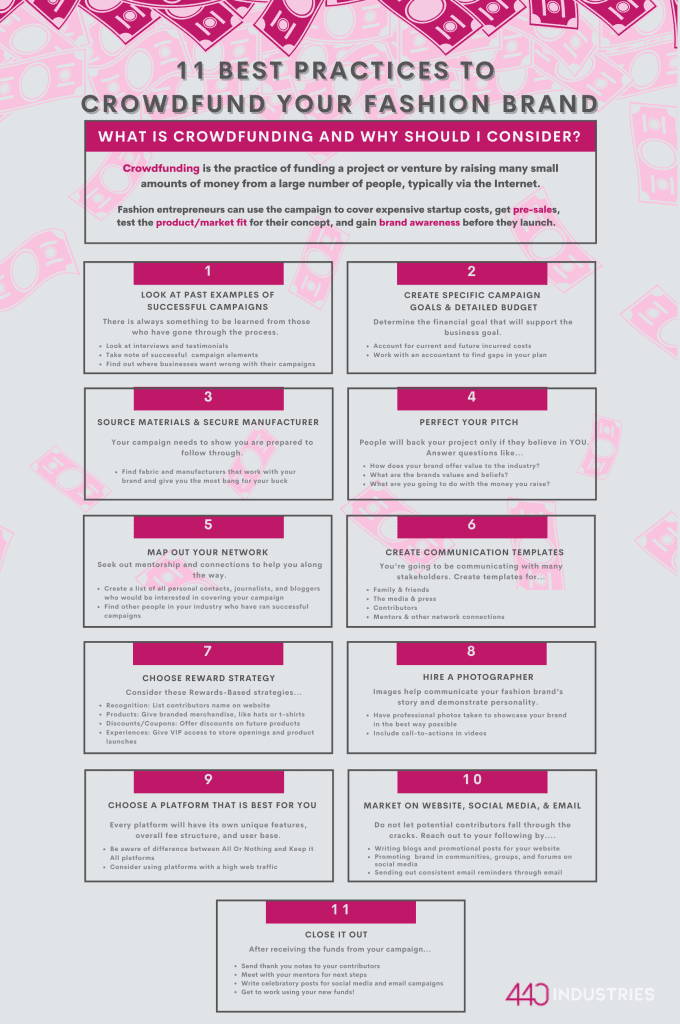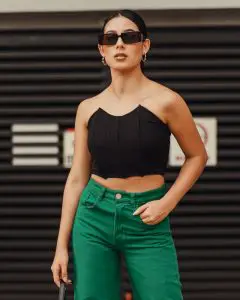Introduction
Asking strangers for money is not easy, especially when you are asking for money to start an entire business! Before crowdfunding existed, entrepreneurs faced a long road to secure funding. Many were left with the options to apply for loans and grants, pitch to venture capitalists, ask friends and family, or tap into their savings. With Crowdfunding, aspiring fashion entrepreneurs can tap into the power of the internet to fund their small business ventures.
Not sure where to start? You’ve landed in the perfect place. In this post, we are going to cover the best practices to crowdfund your fashion brand! You are going to learn exactly what crowdfunding is, why you should consider starting a crowdfunding campaign, and how you can ensure your campaign will prove to be successful in funding your project. Let’s get started!
- What is Crowdfunding?
- Why Should Fashion Entrepreneurs Consider Crowdfunding?
- 11 Best Practices to Crowdfund Your Fashion Brand
- Look at Past Examples of Successful Campaigns
- Create a Specific Campaign Goal and a Detailed Budget
- Source Materials & Secure Manufacturer Partnership
- Perfect Your Pitch
- Map Out Your Network
- Create Templates for Communication
- Choose Reward Strategy
- Hire a Photographer to Take Quality Photos
- Chose a Platform that is Best for You
- Market on Website, Social Media and Through Emails
- Closing It Out
- ..And More Items to Consider
- Conclusion
What Is Crowdfunding?
So, you may be wondering, what exactly is crowdfunding? Crowdfunding is a method that allows startups to collect small donations or investments from a large collection of users in exchange for rewards, goods, equity, or simply appreciation.
This exchange is usually conducted through a crowdfunding platform on the internet, but, there are plenty of startups who have also run successfully in-person crowdfunding campaigns as well!
For creatives like yourself, crowdfunding is a great way to fund your startup, but also bring awareness to your brand as it continues to develop. In this post, we are going to be referencing Rewards-Based Crowdfunding, or seed crowdfunding, which is a type of small-business financing in which entrepreneurs ask for monetary donations from contributors in return for a product, experience, coupon, or service.
Considering these factors, in the next section, we’re going to talk about why crowdfunding–despite the hard work that is required—can be a fruitful way to benefit your fashion startup in more ways than just fiscally.
Why Should Fashion Entrepreneurs Consider Crowdfunding?
Now that we have discussed some of the potential hitches of crowdfunding, let’s talk about how crowdfunding can have a profound impact on your fashion startup and why you should consider using this method.
Crowdfunding can help to raise cash, but it also has added advantages that traditional funding does not offer:
- Your business idea can be validated by a successful campaign. Achieving or exceeding your funding goal indicates there is a desire for your product or service. Any doubts you may have can be cured through this method of conducting a product/market fit test, or a test to see if your product has the potential for customers to buy, use, and tell others at a rate that will sustain the products growth and profitability.
- Financial risk is low. Crowdfunding allows you to test the waters to see if your idea is worthwhile without taking a ton of personal risk. Most platforms charge a small fee to run your campaign and take a portion of taxes out of your sum at the end. In the meantime, you can test the market and receive some consumer feedback before you spend money on pricey inventory, supplies, or production.
- You can tap into an established group — and make a name for your brand. Crowdfunding helps you leverage a dedicated community that is actively looking to support businesses like yours. Use this as an opportunity to build a large community of your own. Together, they will provide critical feedback that you can use to make your idea stronger and help spread your campaign over social media, exposing your concept to a number of people you might be unable to reach. The push through emails and social media can boost your brand awareness.
- You will keep all of your equity. In rewards–based crowdfunding, you’re going to have to give rewards to your backers if your campaign succeeds — but the good news is you will not have to give up any equity or forfeit control of the business.
Now that we have covered the ins and outs crowdfunding, let’s talk about some the best practices for you to follow as you start looking into crowdfunding your fashion brand!
11 Best Practices to Crowdfund Your Fashion Brand
1. Look at Past Examples of Successful Campaigns
Locate interviews and testimonials of business owners who have experience with running crowdfunding campaigns. Pay attention to the lessons they from BOTH their successes and failures. Find some past examples of campaigns that are similar to your goal range and make note of their storytelling approach, forms of media, type of rewards offered, and the look and feel of their overall message
2. Create Specific Campaign Goals and a Detailed Budget
At this point of your startup development, you should have an idea of what your funding goals are for the campaign. Whether you’re looking to fund a new collection, purchase a piece of equipment that will improve the product, or any number of other ideas for growth, you must determine the financial goal that will support the business goal.
When you determine what your funding goal is, you must account for all your incurred costs. Working with an accountant to develop a detailed budget and map out the tax and legal considerations of running a campaign can help you save time and money in the future.

3. Source Materials & Secure Manufacturer Partnership
Many entrepreneurs make the mistake of waiting to find a manufacturer until they are funded from the campaign. This step is often recommended to be completed before you launch, as you need to show your contributors that you are serious about following through with your business proposal. Securing your manufacturer will also give you a better idea of turnaround time, or the amount of time taken to complete a process or fulfill a customer request.
4. Perfect Your Pitch
Contributors will back your project only if they believe in the vision of the project owner. You are the story behind your project and your brand. Tell the story of becoming a fashion entrepreneur, what motivated you, when you started, and how you plan to change the fashion industry.
How does your brand offer value to the industry? To the contributors? What are some of the hardships you are experiencing that could be alleviated through this campaign? What are your values and beliefs as a brand? Who is your target market? What are you going to do with the money you raise? How exactly will it help you? Where do you source materials and where do you manufacture? These are all important questions to address in your pitch.
5. Map Out Your Network
Reach out to potential mentors that will help guide you through this process. It is very important to have support during the early days of your business development. You’ll also want to start a working spreadsheet of all of your potential contacts who may have resources to give you, or who will connect you to people who do. Include any bloggers, journalists, and people in the press who might be interested in covering your story. Networking is everything when it comes to advancing in this industry.
6. Create Templates for Communication
Before, during, and after your campaign, you are going to be in contact with many people. Some may be friends, family, professional connections, potential partners, current customers, and of course your potential contributors. It is in your best interest to create email outreach, social media, campaign page, and thank you note templates before you begin. Not only will this help you craft consistent messaging across the board, but you’ll also be able to reach a larger number of people more quickly and organize your stakeholder communication.
7. Choose Reward Strategy
As mentioned above, we are focusing on rewards-based crowding. If you choose to go with rewards-based campaigning, consider these different types of reward strategies.
- Recognition: For contributors with limited financial capital, offer them an appreciation for their support. You might send a thank you email or note, shout them out online, or add to a public list of supporters.
- Products: Consider developing token brand merchandise, like stickers, cups, hats, or t-shirts to give out to contributors who donate.
- Coupons/Discounts: Although branded products can inspire people to donate to your fundraiser, incentives that give people the opportunity to try out your product or service are even better. Giving discounts, coupons, or vouchers as donation rewards is not just a perfect way to raise the number of contributions fast to offset business costs; it also offers donors the opportunity to fall in love with the business and eventually become loyal customers.
- Experiences: Invite contributors to “experience” your business. Take them on a tour of your future store, invite them to a collection viewing, or give away lifetime VIP passes to any future fashion event.
8. Hire a Photographer to Take Quality Photos
Images help communicate your fashion brand’s story, demonstrate personality and drive personal connections, which is why it is so important to have professionals take photos of you and your work. Most platforms allow you to place images and videos of you, your brand, your collection, or your studio. Great product images have good lighting and white background. If creating a video, make sure to use a script and include call-to-actions.
9. Chose a Platform that is Best for You
Every crowdfunding platform will have its own unique features, overall fee structure, and user base. Different crowdfunding platforms will offer different advantages depending on how it works with your specific industry and brand. Platforms like Kickstarter have high web traffic and high success rate among projects.
One potential downside is that it runs All or Nothing Campaigns, which means that if you do not meet your funding goal, you will not receive any of the accrued funds. Another large platform is IndieGogo, which runs Keep It All Campaigns. It is exactly what it sounds like: you keep all your funding regardless if you meet your goal. The downside of K.I.A. Campaigns is that they typically have higher transaction fees. Choose a platform that works best with your current business model, costs, and future needs.
10. Market on Website, Social Media, and through Emails
To have the best chances of having a successful campaign, get ready to market. Start by making a list of groups, forums, or any communities to join on social media platforms. You might to start posting “teasers” of the upcoming campaign launch and what contributors can expect to receive. You’ll also want to target your email contact list. Make every piece of correspondence personable by adding name merge tags. All in all, you should be sending a teaser, a launch, a half-way there, and a last chance post and email. Include call to actions and links for viewers to forward the post or email to their friends.
11. Closing it Out
After receiving the funds from your campaign, make sure to do the following:
- Promptly send thank you notes to your contributors.
- Meet with your mentors and financial advisors to receive advice for the steps ahead.
- Write celebratory posts for social media and email campaigns.
- Write a formal article to send to the media as a press release.
- Update website with campaign progress.
- Finally, get the ball rolling on the rewards and business proposal promises you made to contributors!
…And More Items to Consider
Make no mistake, even though crowdfunding allows you to sidestep traditional gatekeepers of small business financing, it still takes some work if you want your campaign to come out on top. While crowdfunding sounds attractive, it is important that you comprehend all that it entails. Here are four important things you must understand about crowdfunding:
- There is no certainty that this is going to lead to success. But remember, there are other benefits to crowdfunding besides just the funding.
- It takes a great deal of work. You will need to be prepared to spend time exploring options, understanding rules and regulations, requirements and expectations, creating marketing and advertising plans, and highlighting brand potential before any funds are sent to you.
- Crowdfunding requires you to have a strategy to use the funds to optimize the growth of your brand and show return on investment for those who donated or invested money. You need to know how to properly use your funds once you have access to them.
- Crowdfunding may be a full-time project. It requires proper planning, a determination to succeed, and a follow-up that is entirely separate from starting your business.
Do not be discouraged. By using our list of best practices as a guide, you will be well on your way to developing a successful campaign.
Conclusions
We know the challenge of financing your fashion startup is a tough one. It can distract you from enjoying what you love to do and make for an unfavourable experience in what is supposed to be an exciting time of your life.
While crowdfunding does not guarantee the success of a project or the longevity of a brand, it does help many fashion entrepreneurs gain business experience and form relationships for additional opportunities.
Fortunately, employing the strategies above can greatly improve the chance of success of your startup funding campaign. Let’s review what we learned:
- Crowdfunding is a method that allows startups to collect small donations or investments from a large collection of users in exchange for rewards, goods, equity, or simply appreciation. There are different types of crowdfunding, but for smaller fashion brands, rewards-based is often the best choice because it gives something in return to contributors without giving equity of the business.
- Every platform is different, so you’ll want to research to see which is going to be the best for your brand.
- Networking and marketing are key! Do not rely on organic traffic on the platforms. Your campaign has less of a chance to fall through the cracks if you are strategically promoting it.
- To make the campaigning process as least stressful as possible, seek out mentors, advisors, and people who have gone through this process before. Create communication templates, detailed budgeting guide, and connections with potential manufacturers.
Thank you for reading, and we wish you the best of luck on your crowdfunding journey!








